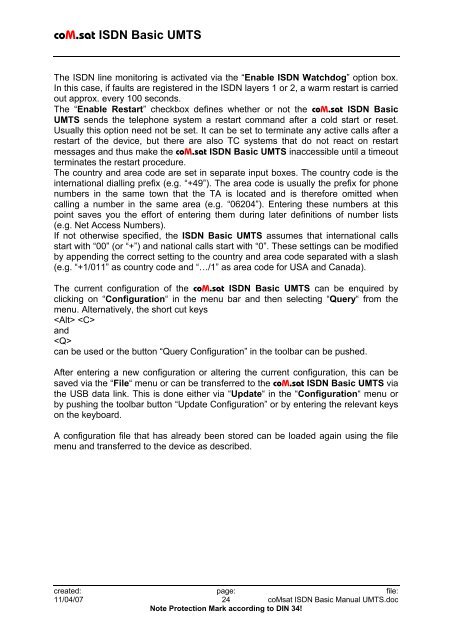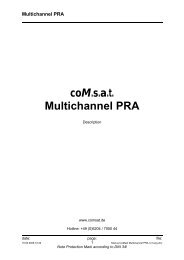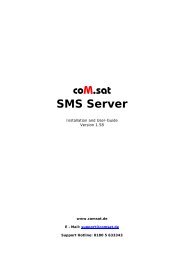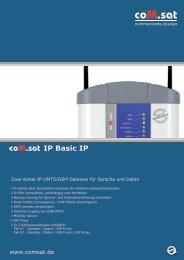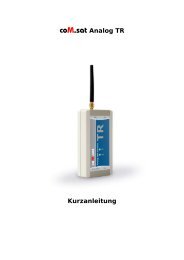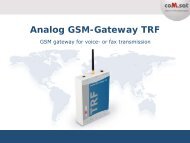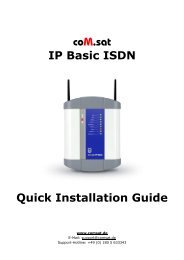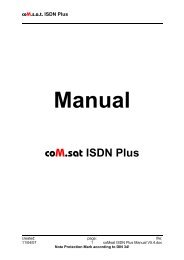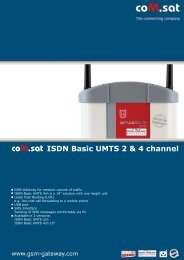coM.sat ISDN Basic UMTS
coM.sat ISDN Basic UMTS
coM.sat ISDN Basic UMTS
You also want an ePaper? Increase the reach of your titles
YUMPU automatically turns print PDFs into web optimized ePapers that Google loves.
<strong>coM</strong>.<strong>sat</strong> <strong>ISDN</strong> <strong>Basic</strong> <strong>UMTS</strong><br />
The <strong>ISDN</strong> line monitoring is activated via the “Enable <strong>ISDN</strong> Watchdog” option box.<br />
In this case, if faults are registered in the <strong>ISDN</strong> layers 1 or 2, a warm restart is carried<br />
out approx. every 100 seconds.<br />
The “Enable Restart” checkbox defines whether or not the <strong>coM</strong>.<strong>sat</strong> <strong>ISDN</strong> <strong>Basic</strong><br />
<strong>UMTS</strong> sends the telephone system a restart command after a cold start or reset.<br />
Usually this option need not be set. It can be set to terminate any active calls after a<br />
restart of the device, but there are also TC systems that do not react on restart<br />
messages and thus make the <strong>coM</strong>.<strong>sat</strong> <strong>ISDN</strong> <strong>Basic</strong> <strong>UMTS</strong> inaccessible until a timeout<br />
terminates the restart procedure.<br />
The country and area code are set in separate input boxes. The country code is the<br />
international dialling prefix (e.g. “+49”). The area code is usually the prefix for phone<br />
numbers in the same town that the TA is located and is therefore omitted when<br />
calling a number in the same area (e.g. “06204”). Entering these numbers at this<br />
point saves you the effort of entering them during later definitions of number lists<br />
(e.g. Net Access Numbers).<br />
If not otherwise specified, the <strong>ISDN</strong> <strong>Basic</strong> <strong>UMTS</strong> assumes that international calls<br />
start with “00” (or “+”) and national calls start with “0”. These settings can be modified<br />
by appending the correct setting to the country and area code separated with a slash<br />
(e.g. “+1/011” as country code and “…/1” as area code for USA and Canada).<br />
The current configuration of the <strong>coM</strong>.<strong>sat</strong> <strong>ISDN</strong> <strong>Basic</strong> <strong>UMTS</strong> can be enquired by<br />
clicking on “Configuration“ in the menu bar and then selecting “Query“ from the<br />
menu. Alternatively, the short cut keys<br />
<br />
and<br />
<br />
can be used or the button “Query Configuration” in the toolbar can be pushed.<br />
After entering a new configuration or altering the current configuration, this can be<br />
saved via the “File“ menu or can be transferred to the <strong>coM</strong>.<strong>sat</strong> <strong>ISDN</strong> <strong>Basic</strong> <strong>UMTS</strong> via<br />
the USB data link. This is done either via “Update“ in the “Configuration“ menu or<br />
by pushing the toolbar button “Update Configuration” or by entering the relevant keys<br />
on the keyboard.<br />
A configuration file that has already been stored can be loaded again using the file<br />
menu and transferred to the device as described.<br />
created: page: file:<br />
11/04/07 24 <strong>coM</strong><strong>sat</strong> <strong>ISDN</strong> <strong>Basic</strong> Manual <strong>UMTS</strong>.doc<br />
Note Protection Mark according to DIN 34!


